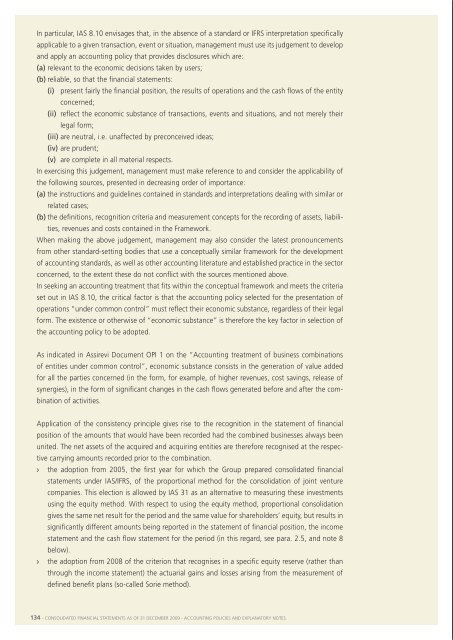Financial Statements 2009 - Manutencoop
Financial Statements 2009 - Manutencoop
Financial Statements 2009 - Manutencoop
Create successful ePaper yourself
Turn your PDF publications into a flip-book with our unique Google optimized e-Paper software.
In particular, IAS 8.10 envisages that, in the absence of a standard or IFRS interpretation specificallyapplicable to a given transaction, event or situation, management must use its judgement to developand apply an accounting policy that provides disclosures which are:(a) relevant to the economic decisions taken by users;(b) reliable, so that the financial statements:(i) present fairly the financial position, the results of operations and the cash flows of the entityconcerned;(ii) reflect the economic substance of transactions, events and situations, and not merely theirlegal form;(iii) are neutral, i.e. unaffected by preconceived ideas;(iv) are prudent;(v) are complete in all material respects.In exercising this judgement, management must make reference to and consider the applicability ofthe following sources, presented in decreasing order of importance:(a) the instructions and guidelines contained in standards and interpretations dealing with similar orrelated cases;(b) the definitions, recognition criteria and measurement concepts for the recording of assets, liabilities,revenues and costs contained in the Framework.When making the above judgement, management may also consider the latest pronouncementsfrom other standard-setting bodies that use a conceptually similar framework for the developmentof accounting standards, as well as other accounting literature and established practice in the sectorconcerned, to the extent these do not conflict with the sources mentioned above.In seeking an accounting treatment that fits within the conceptual framework and meets the criteriaset out in IAS 8.10, the critical factor is that the accounting policy selected for the presentation ofoperations “under common control” must reflect their economic substance, regardless of their legalform. The existence or otherwise of “economic substance” is therefore the key factor in selection ofthe accounting policy to be adopted.As indicated in Assirevi Document OPI 1 on the “Accounting treatment of business combinationsof entities under common control”, economic substance consists in the generation of value addedfor all the parties concerned (in the form, for example, of higher revenues, cost savings, release ofsynergies), in the form of significant changes in the cash flows generated before and after the combinationof activities.Application of the consistency principle gives rise to the recognition in the statement of financialposition of the amounts that would have been recorded had the combined businesses always beenunited. The net assets of the acquired and acquiring entities are therefore recognised at the respectivecarrying amounts recorded prior to the combination.> the adoption from 2005, the first year for which the Group prepared consolidated financialstatements under IAS/IFRS, of the proportional method for the consolidation of joint venturecompanies. This election is allowed by IAS 31 as an alternative to measuring these investmentsusing the equity method. With respect to using the equity method, proportional consolidationgives the same net result for the period and the same value for shareholders’ equity, but results insignificantly different amounts being reported in the statement of financial position, the incomestatement and the cash flow statement for the period (in this regard, see para. 2.5, and note 8below).> the adoption from 2008 of the criterion that recognises in a specific equity reserve (rather thanthrough the income statement) the actuarial gains and losses arising from the measurement ofdefined benefit plans (so-called Sorie method).Uncertainty of estimatesThe principal assumptions about the future are presented below, together with other major sources ofuncertainty affecting the year-end estimates. These may result in significant adjustments being madeto the carrying amounts of assets and liabilities within the next financial year.Impairment of goodwillGoodwill is subjected to impairment testing on an annual basis, or more frequently; this work involvesestimating the fair value and/or value in use of the cash-generating unit to which the goodwill wasallocated. This estimate reflects the present value of the unit’s forecast cash flows, determined usingan appropriate discounting rate. As of 31 December <strong>2009</strong>, the carrying amount of goodwill is Euro384,905 thousand (31 December 2008 restated: Euro 356,409 thousand). Further details are providedin notes 6 and 7.Identification of the present value of the liability for put options on minority interests in subsidiaries and thepresent value of the liability for additional purchase price payments (earn-out) in relation to acquisitions madeThe Group has majority interests in 2 subsidiaries whose minority shareholders hold put options thatmay be exercised in future, at prices determinable using certain parameters that require managementto make estimates in order to obtain a reliable valuation.In addition, the original contract for the purchase of one of these majority interests envisages recognitionto the sellers, the current minority shareholders, of an earn-out if certain conditions are met at aspecified future date. Here too, proper recognition of the related liability requires the use of parametersthat must be estimated by management.Other balance sheet captionsManagement has also necessarily made estimates to determine:> deferred tax assets, especially in relation to the likelihood of future reversals of the related temporarydifferences,> provisions for doubtful accounts and provisions for risks and charges;> key assumptions for the actuarial recalculation of employee severance indemnities, namely the expectedfuture turnover rate, inflation rate and the discount rate,> contract work in progress, especially with regard to the total completion costs used to determine thepercentage stage of completion.2.4 Consolidation principlesThe consolidated financial statements comprise the financial statements of <strong>Manutencoop</strong> Facility ManagementS.p.A. and its subsidiaries, prepared as of 31 December. The financial statements of subsidiariesare prepared at each period end using the accounting policies adopted by the parent company.All intercompany transactions and balances, as well as any related unrealised profits and losses includedin asset accounts, are eliminated in full.Subsidiaries are consolidated on a line-by-line basis from the date of acquisition, or from the date onwhich the Group obtains control over them, and are deconsolidated when control is transferred outsideof the Group.With the exception of acquisitions deriving from the business combination of entities under commoncontrol, as explained in para. 2.3 above, the acquisition of subsidiaries is recorded using the purchasemethod, which involves allocating the purchase cost of a company to the fair value of its assets, liabilitiesand contingent liabilities at the time of acquisition, and recognising in the consolidated financialstatements its results from the acquisition date to the end of the year.Minority interests comprise the portion of profits or losses and net assets attributable to the minority134 - Consolidated financial statements as of 31 December <strong>2009</strong> - Accounting policies and explanatory notes Consolidated financial statements as of 31 December <strong>2009</strong> - Accounting policies and explanatory notes - 135








